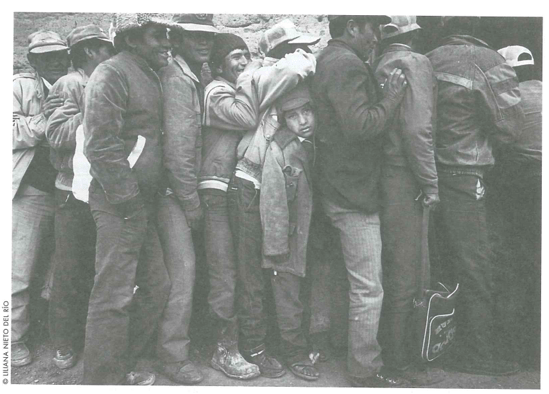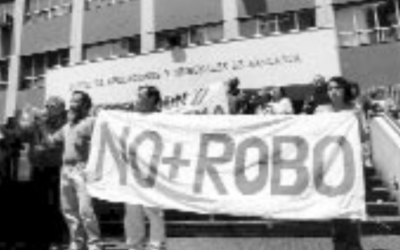Proclaiming the Jubilee
Global Coalition Demands Further Debt Relief for Poorest Countries

Working in Bolivia.
Carmen Rodríguez heads the Charismatic Movement in a sprawling shantytown parish south of Lima, Peru. She and other lay leaders of the Lurín Diocese have been preparing for the upcoming millennium in an unusual way. Earlier this year, after having participated in Lenten workshops offering economic and theological perspectives on debt relief, they went door-to-door and gathered some 90,000 signatures on an internationally circulated petition calling for a one-time cancellation of the unpayable debt of highly indebted poor countries by the end of the year 2000. Countrywide, more than 1,850,000 Peruvians signed the petition in just three months’ time. Worldwide, 17 million people from over 160 countries signed the petition, which was presented to G-7 leaders in Cologne, Germany in June. The delegation presenting the petition signatures to German Chancellor Gerhard Schroeder, who accepted then in the name of the G-7 leaders, included such disparate figures as Archbishop Oscar Rodriguez Maradiaga of Tegucigalpa, Honduras and Bono of the Irish rock group U-2.
An extraordinary global coalition of churches, anti-poverty groups, and other civil society organizations, called the Jubilee 2000 campaign, organized the petition drive. Invoking a biblical norm from the Book of Leviticus, the campaign is urging the international community to mark the millennium by recognizing a period of “jubilee” in which debts are forgiven and the freed up resources are used to alleviate poverty. Campaign organizers, led by such groups as Christian Aid (UK), OXFAM, EURODAD (the European Network on Debt and Development), and Catholic national episcopal conferences, relief agencies, and the Vatican, argue that heavily indebted countries devote an inordinate portion of their national budgets to making interest payments on the debt, leaving too little available for desperately needed outlays for health, education, housing and job creation. They also charge that structural adjustment programs (SAPs), mandated by the International Monetary Fund in conjunction with debt rescheduling and relief, have placed a disproportionate burden on the poor. Jeffrey Sachs, director of the Center for International Development at Harvard, serves as an advisor to the group and has met with the Pope on the issue.
The Latin American debt crisis had previously centered attention on large, middle income countries whose possible default on loans threatened the stability of the international financial system. Limited debt reduction and rapidly expanding private sector investment in “emerging market” countries in the late 1980s largely defused the crisis in the eyes of creditor country policymakers and the international media. However, a movement grew to press for debt relief for the poorest, most heavily indebted countries, which tend to owe the vast majority of their external debt to bilateral and multilateral creditors rather than commercial lenders.
In September 1996, the leadership of the IMF and World Bank launched the Heavily Indebted Poor Country (HIPC) Initiative as the first comprehensive plan to reduce the bilateral and multilateral debt of qualifying countries to sustainable levels. While the overwhelming majority of the 41 countries that currently qualify for HIPC debt relief are in Sub-Saharan Africa, they also include Bolivia, Guyana, Honduras and Nicaragua.
The Cologne Debt Initiative
The G-7 leaders meeting in Cologne responded to widespread criticism that HIPC debt relief must be deeper, broader and faster. To date, only four of the HIPC countries (including Bolivia and Guyana) have advanced to a point in the review process at which they have actually received debt relief. At Cologne, the G-7 leaders agreed in principle to cancel an additional $45 billion of the bilateral and multilateral debt owed by the 41 qualifying countries. This is to be added to the $55 billion already proposed through the Paris Club of bilateral creditors ($30 billion) and the HIPC Initiative ($25 billion).
The Cologne Initiative would also lower the level of debt which is considered “sustainable” under HIPC (principally measured by two ratios: a net present value of debt of 150 percent of annual export earnings, down from 200-250 percent under HIPC, and, for countries highly dependent on export income, a net present value of debt of 250 percent of annual government revenue, down from 280 percent). Countries with debt above this level are also to begin to receive debt relief after demonstrating compliance with IMF-mandated structural adjustment for three years, down from six years under HIPC. The G-7 leaders also directed the IMF and the World Bank to assist qualifying countries in the drafting and implementation of poverty reduction plans “for the effective targeting of savings derived from debt relief, together with increased transparency of budgetary procedures to protect social expenditure.” The leaders also recommend, but do not require that the IMF and World Bank consult civil society groups in the design and implementation of such programs.
While Jubilee 2000 leaders especially welcomed the explicit link between debt relief and poverty reduction, the call for civil society participation, and greater transparency of budgetary procedures to protect social expenditures, they nonetheless objected to several features of the plan:
The amount of relief is still insufficient. Critics suggest that the debt-to-export earnings ratio of 150 percent and debt-to-government revenue ratio of 250 percent are still much too high to be considered “sustainable.” Critics such as Sachs have charged that the IMF and the World Bank could afford far more extensive relief. (SEE SIDE BAR?) The G-7 leaders did call for the IMF to sell up to 10 million ounces of its gold reserves to finance both HIPC debt relief and IMF concessional loans available through its Enhanced Structural Adjustment Facility (ESAF). They also called for governments and the private sector to contribute to a special Millennium Fund and the existing HIPC Trust Fund to finance reductions in debt service payments. Some creditor country legislatures are reluctant to fund more relief. For example, H.R. 1095, “The Debt Relief for Poverty Reduction Act of 1999,” is a bill endorsed by some Jubilee 2000 member organizations that has garnered bipartisan support, and yet it still faces an uphill battle in the U.S. Congress.
Too few countries will receive relief. The Jubilee 2000 campaign (UK) has estimated that of the 41 HIPC countries, perhaps 24 will qualify for some reduction in debt service payments by the end of the year 2000, and that the reduction will be significant for only 16 of these. No additional debt relief was offered to countries that do not qualify as HIPCs but also have high debt servicing requirements which impede government commitment to poverty reduction. Among Latin American countries, the World Bank categorizes Haiti as a “Severely Indebted Low Income Country,” and Argentina, Brazil, Ecuador, Jamaica, and Peru are considered “Severely Indebted Middle Income Countries”; however, none of these countries will receive additional debt relief under the HIPC or Cologne Initiatives. In addition, countries emerging from armed conflicts and/or natural disasters require special treatment. After Hurricane Mitch, creditors granted Honduras and Nicaragua a two-year moratorium on debt servicing, but critics point out that interest is continuing to accrue during this period, and that a more lasting solution must be found. The IMF, World Bank, and bilateral creditors are currently negotiating more substantive debt reduction packages with the two countries’ governments.
The IMF and the World Bank will wield more control over the debt reduction process. Countries receiving debt relief must still undergo structural adjustment through the IMF’s ESAF, which critics have long charged exacerbates poverty and contributes to environmental degradation. Jubilee 2000 supporters have demanded that civil society groups be consulted in IMF and World Bank programs for their countries as well as any poverty reduction programs, and question the increased IMF role in designing the latter, given its track record on sustainable development. The IMF and the World Bank leaders have committed their institutions to a comprehensive review of HIPC, including consultation with civil society groups. At a July seminar in Addis Ababa, Ethiopia, representatives of creditor and debtor country governments, the IFIs, regional development banks, relevant UN agencies, and African and Northern NGOs met to examine practical ways to strengthen the link between debt relief and poverty reduction. Conference participants agreed that ESAF should be revamped to strengthen its focus on poverty reduction.

Working in Azuay, Ecuador.
Network features
While the “jubilee” norm has undergirded the work of NGOs and churches pressing for debt relief since the late 1970s, the upcoming millennium has provided the motivation for a reinvigoration and rapid expansion of the network. Also, as in the cases of other transnational networks that have coalesced to work on issues such as human rights, protection of the environment, and women’s rights, North-South collaboration of advocates for debt relief has been much facilitated by e-mail and web sites that provide activists a readily accessible medium for information exchange.
Within the debt network, groups with diverse strengths collaborate. Some mobilize constituencies for demonstrations and lobbying, others conduct research and provide alternative information, and others exert moral suasion, such as the Vatican and regional and national episcopal conferences. A distinct feature of the network as compared with other transnational networks has been the unusual leading role of churches. The World Council of Churches, the bishops of the Anglican Communion, Pope John Paul II, and national Catholic bishops conferences of various creditor and debtor countries have all called for more extensive debt forgiveness.
A reformist/radical cleavage has marked the network since the mid-1980s, increasingly lining up on a North/South axis. While many Northern-based members have been willing (albeit reluctantly) to support legislation financing debt reduction with continued SAP conditionality, other network members, principally in debtor countries reject any such conditionality and demand wholesale debt cancellation. The Tegucigalpa Declaration, issued last January by Latin American Jubilee 2000 campaigners from 16 countries gathered in the Honduran capitol, pointedly requested that Northern groups not accept terms less favorable than those demanded by their Southern allies. Southern groups are particularly concerned that by accepting the Cologne Initiative consideration of further debt reduction will be cut off.
Father Tomás Burns, a Maryknoll priest in Perú active on the debt issue for over 20 years, recounted in a telephone conversation the exceptional effort Peruvians made to gather signatures on the Jubilee 2000 petition, knowing that Peru would not receive additional debt relief under the HIPC Initiative. “We’ve seen what it is in Peru to sacrifice a generation because of the debt overhang and insufficient funds for education and health. It’s a case of the people here expressing their solidarity with the poor in Sub-Saharan Africa, what we call ‘globalization from below’: South-South solidarity.”
Fall 1999
Elizabeth A. Donnelly is a Ph.D. candidate in the Government Department. She served as a Mary. knoll Lay Missioner in Lima, Peru from 1981-1983, and holds an M. T.S. from Harvard Divinity School. Her article on the transnational network of organizations advocating debt relief will appear in Sanjeev Khagram, James V. Riker, and Kathryn Sikkink (eds.), Restructuring World Politics: Transnational Social Movements, Networks and Norms (University of Minnesota Press, forthcoming).
Related Articles
Poverty or Potential?
Teresa stops me three blocks from Nueva Imperial’s main plaza on a quiet Wednesday morning, eager to chat. She is wearing a light blue sweater and a matching blue headband glowing slightly against her dark black hair.
Infections and Inequalities
I read Paul Farmer’s book while on a short visit to Venezuela, and found that setting, at this historical moment in time, particularly pertinent and highly conducive to the arguments Farmer…
Its Strengths, Problems, and Future
Latin America can take a punch. Its endurance of a whole series of rather large shocks in the last two years is a tribute to the region’s extensive structural reforms. The consequences a decade…



